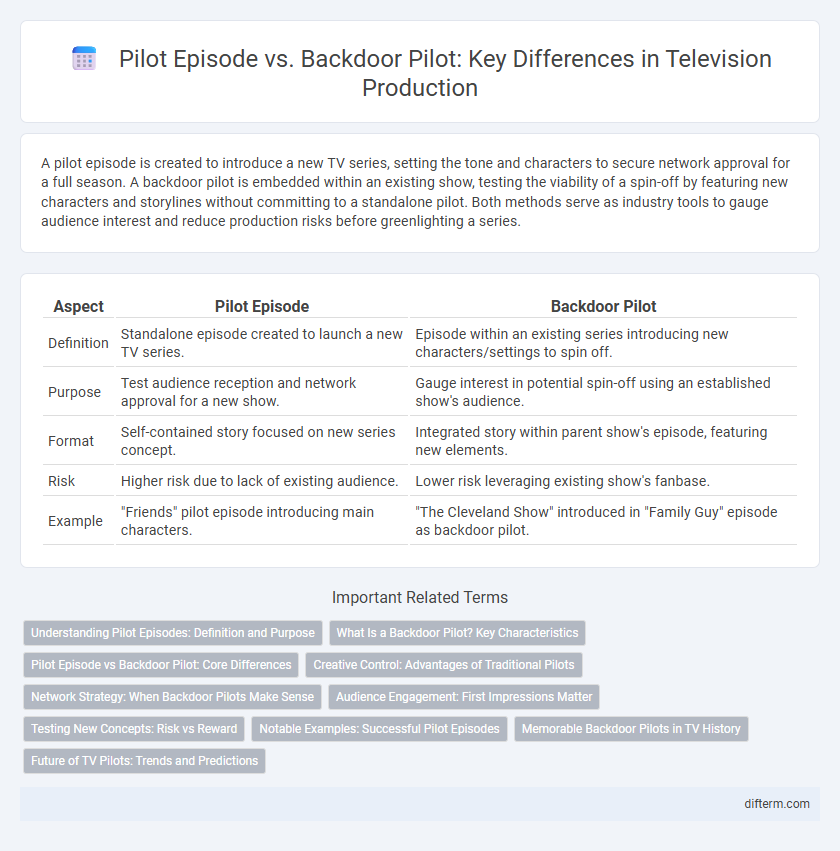A pilot episode is created to introduce a new TV series, setting the tone and characters to secure network approval for a full season. A backdoor pilot is embedded within an existing show, testing the viability of a spin-off by featuring new characters and storylines without committing to a standalone pilot. Both methods serve as industry tools to gauge audience interest and reduce production risks before greenlighting a series.
Table of Comparison
| Aspect | Pilot Episode | Backdoor Pilot |
|---|---|---|
| Definition | Standalone episode created to launch a new TV series. | Episode within an existing series introducing new characters/settings to spin off. |
| Purpose | Test audience reception and network approval for a new show. | Gauge interest in potential spin-off using an established show's audience. |
| Format | Self-contained story focused on new series concept. | Integrated story within parent show's episode, featuring new elements. |
| Risk | Higher risk due to lack of existing audience. | Lower risk leveraging existing show's fanbase. |
| Example | "Friends" pilot episode introducing main characters. | "The Cleveland Show" introduced in "Family Guy" episode as backdoor pilot. |
Understanding Pilot Episodes: Definition and Purpose
A pilot episode serves as the initial scripted installment of a television series, designed to showcase the show's concept, characters, and tone to networks and audiences. It functions as a testing ground to gauge viewer interest and network approval before committing to a full season production. In contrast, a backdoor pilot is embedded within an existing series, introducing new characters or storylines to assess potential spin-offs without producing a separate standalone episode.
What Is a Backdoor Pilot? Key Characteristics
A backdoor pilot is a specific type of pilot episode designed to introduce a potential new series through an existing show, serving as a test for audience interest without committing to a standalone pilot. Key characteristics include integrating new characters or storylines within the established series, providing a seamless narrative transition that gauges viewership reaction. This approach reduces production costs and leverages an existing fan base to determine the viability of the new show concept.
Pilot Episode vs Backdoor Pilot: Core Differences
A pilot episode serves as the first standalone installment designed to establish a show's concept, characters, and tone, intended for network evaluation to greenlight the series. In contrast, a backdoor pilot is embedded within an existing show's episode, introducing new characters or settings to test audience interest without producing a separate standalone pilot. This strategic approach allows networks to gauge viewer response to potential spin-offs while minimizing production costs and risks.
Creative Control: Advantages of Traditional Pilots
Traditional pilot episodes offer creators substantial creative control, allowing them to fully develop characters, story arcs, and tone without network interference. This autonomy enables a clearer vision and more cohesive storytelling, enhancing the show's potential for success. In contrast, backdoor pilots often face constraints due to their integration within existing series, limiting creative freedom and narrative depth.
Network Strategy: When Backdoor Pilots Make Sense
Backdoor pilots serve as strategic tools for networks to test audience reception within an established series, minimizing financial risk compared to traditional pilot episodes. They enable networks to gauge potential success and gather real-time viewer feedback before fully committing to a standalone show. This approach is especially effective when expanding a popular franchise or exploring a new spin-off concept.
Audience Engagement: First Impressions Matter
A pilot episode serves as the definitive introduction to a new series, crafted to captivate the audience and secure long-term viewership by showcasing core characters and plotlines. Backdoor pilots integrate a test storyline within an existing show, aiming to engage existing fans while subtly gauging interest in a potential spin-off. Effective audience engagement relies heavily on first impressions, as a well-executed pilot or backdoor pilot can drive strong viewer retention and generate buzz for the series launch.
Testing New Concepts: Risk vs Reward
Pilot episodes serve as standalone tests for new TV concepts, allowing networks to gauge audience reaction and potential success before committing to a full series, minimizing financial risk. Backdoor pilots integrate new show concepts into existing series episodes, leveraging established fanbases to test ideas with lower upfront costs but carry the risk of tonal or narrative mismatch. Both strategies balance creative innovation with financial prudence, impacting network decisions on show development and investment.
Notable Examples: Successful Pilot Episodes
Notable successful pilot episodes include "Breaking Bad," which established a compelling narrative that led to critical acclaim and a dedicated fanbase. In contrast, backdoor pilots like "The Originals," introduced through "The Vampire Diaries," effectively tested audience interest before launching a new series. These strategies showcase how pilot episodes and backdoor pilots contribute to the strategic development and success of television franchises.
Memorable Backdoor Pilots in TV History
Memorable backdoor pilots in TV history include shows like "The Andy Griffith Show," which debuted as an episode of "The Danny Thomas Show," and "The Jeffersons," introduced through "All in the Family." These episodes serve as stealth introductions to potential spin-offs, allowing networks to test audience reception without committing to a full series upfront. Backdoor pilots often feature key characters and settings, seamlessly integrating new narratives into established shows to build viewer interest effectively.
Future of TV Pilots: Trends and Predictions
The future of TV pilots is shifting towards streamlined production with a growing preference for backdoor pilots embedded within established series, allowing networks to gauge audience reaction before committing to full spin-offs. Data from recent industry reports indicate a 35% increase in backdoor pilot usage over traditional standalone pilots, driven by cost-efficiency and enhanced viewer engagement metrics. This trend predicts a continued rise in hybrid pilot formats that blend narrative testing with audience analytics to optimize content success in the evolving entertainment landscape.
pilot episode vs backdoor pilot Infographic

 difterm.com
difterm.com